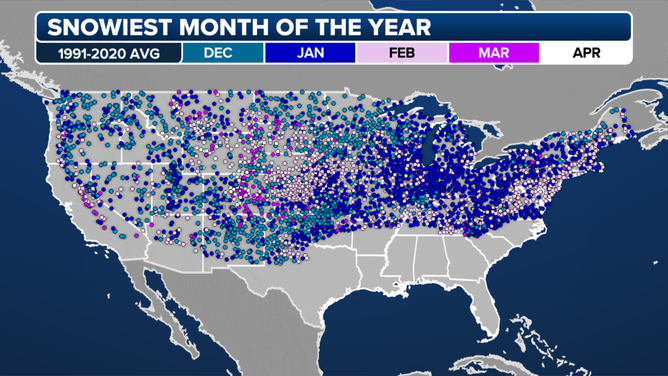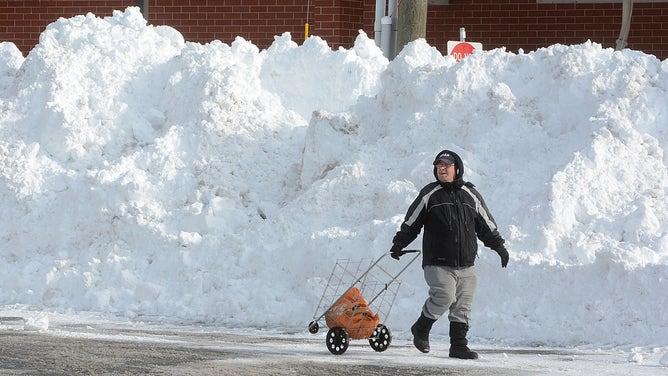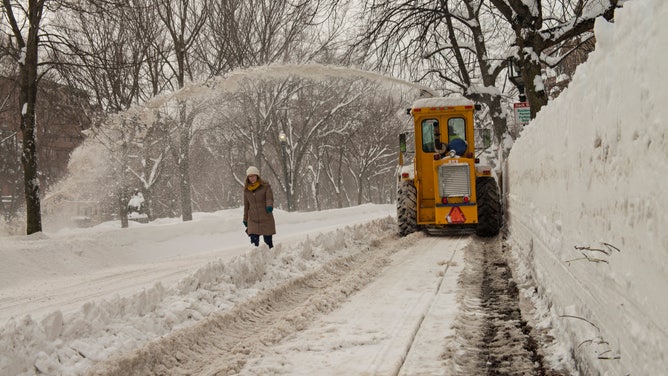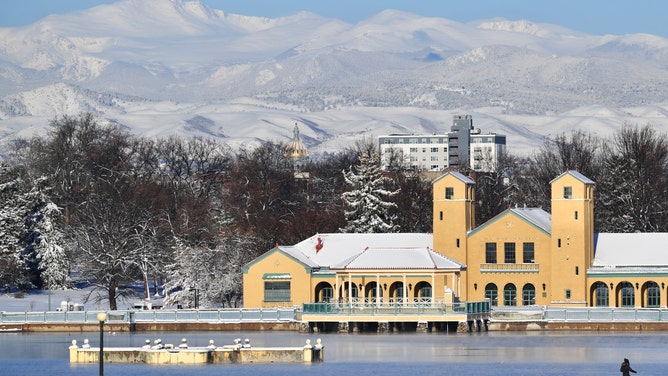Which is the snowiest month of the year?
The snowiest month varies by region, but February is typically the snowiest along the I-95 corridor in the Northeast and mid-Atlantic, including the cities of Boston, New York, Philadelphia and Washington.
Which month is snowiest?
Which month is snowiest? The short answer: It depends on where you live.
Not every city sees its snowiest month over the winter. Some snowy seasons stretch well into spring. So when does your city see the most snow?
The short answer: It depends on where you live.
Plotted on the map below are 3,980 dots, with each color indicating which month is the snowiest at that location, based on the most recent 30-year climatological averages (1991-2020) calculated by NOAA's National Centers for Environmental Information.
In order to be included in the analysis, a location must have recorded at least 20 years with measurable snow (0.1 inches or greater) in the 1991-2020 period, so that excluded much of the southern tier of the U.S. since snowfall there is relatively infrequent.
THESE ARE THE 7 SNOWIEST CITIES IN THE U.S.

Colored dots indicate which month is the snowiest based on the most recent 30-year climatological averages (1991-2020).
(FOX Weather)
December
The map shows December is the snowiest month of the year in parts of the Northwest and Southwest.
Winter's first month is also the snowiest in portions of the central U.S., including parts of North Dakota, eastern South Dakota, Minnesota, northern Wisconsin, southern Kansas, northern Oklahoma and the Texas Panhandle, as well as a small portion of far northern Maine along the U.S.-Canada border.
January
January, however, is the snowiest month for the majority of the Midwest and East, from the mid-Mississippi and Ohio valleys to the Great Lakes, Appalachians and interior Northeast. This includes the cities of Chicago, Buffalo in New York and Nashville in Tennessee.

File: A resident passes near roadside snow on November 21, 2014 in Buffalo,
(Patrick McPartland / Anadolu Agency / Getty Images)
The first month of the new year also claims the title for the snowiest in portions of eastern Nebraska, eastern and southern Kansas, southern Oklahoma and the Intermountain West.
February
If you live along the Interstate 95 corridor in the Northeast and mid-Atlantic, February is typically your snowiest month, with snowstorms tending to favor a track up the East Coast. Boston, New York City, Philadelphia and Washington, D.C. all tend to receive the largest chunk of their seasonal snowfall in February.
February is also the snowiest month of the year for portions of the northern and central Plains, western Iowa and northwestern Texas. Parts of the mid-South also pick up most of their snowfall during February in an average winter.
WE'VE ENTERED THE PEAK TIME OF YEAR FOR MAJOR NORTHEAST WINTER STORMS

A large snowblower removes snow on Commonwealth Avenue in Boston, where over 7 feet of snow had fallen in the 3 weeks ending Feb. 15, 2015.
(Rick Friedman / Corbis / Getty Images)
March
March, the first month of meteorological spring, is the snowiest for much of the Rockies and parts of the adjacent High Plains. This includes Denver, which averages 8.8 inches of snow each March. Gulf of Mexico moisture typically surges farther northward once March arrives, injecting any storm systems with an abundance of moisture that can fall as snow if temperatures are cold enough.
DRIVING IN LIGHT SNOW IS JUST AS DANGEROUS AS A MAJOR SNOWSTORM, RESEARCHERS SAY

Photo shows a snow-covered City Park along the Front Range of the Rockies in Denver on Tuesday, April 20, 2021.
(Hyoung Chang / MediaNews Group / The Denver Post / Getty Images)
April
There are even places in the U.S. that get their most snowfall in April when the rest of the nation is getting ready to swap out their sweaters and winter coats for t-shirts and shorts. All of these locations that call April their snowiest month are in the northern or central Rockies and adjacent High Plains. In particular, the Black Hills of South Dakota is a region notorious for very late-season heavy snowstorms.
WHEN CAN YOU EXPECT THE LAST SNOW OF THE SEASON?
If you don't like the snow, we recommend not visiting Mount Rushmore, South Dakota, in April – its snowiest month, with an average of 12.4 inches of snow. Residents of Lead, South Dakota, can also claim April as their snowiest month, averaging an astounding 29.2 inches over those 30 days.





